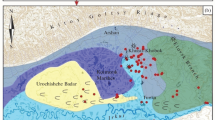Abstract
Based on the brief review and detailed analysis of the results obtained in the course of investigation of chemical and other characteristics of tundra soils in Russia, we developed a procedure for calculation of essential agrochemical properties of natural and disturbed soil cover in tundra to make quantitative evaluations of the ecological danger of its degradation. The initial data for calculation were the values of humus content in the soil layer 0–20 cm. They were either obtained experimentally or calculated based on correlations with soil annealing losses, hygroscopic humidity of the upper soil layer and its organic constituent, and the qualitative characterization of wetting and thermal conditions during the vegetation period. In order to illustrate the sequence and relevance of calculative determinations, we give a sample calculation and application of its results.
Similar content being viewed by others
References
Vasil’evskaya, V.D. and Grigor’ev, V.Ya., Erosion Processes of the Central Yamal, in Erozionnye protsessy tsentral’nogo Yamala (Erosive Processes of the Central Yamal), St. Petersburg, 1999, pp. 54–89.
Vasil’evskaya, V.D. and Grigor’ev, V.Ya., Biological Indexes of Degradation and Self-Restoration of Soil-Plant Cover of Tundra, Sibirskii Ekologicheskii Zhurnal, 2002, no. 3, pp. 355–370.
Vasil’evskaya, V.D. and Grigor’ev, V.Ya., Indexes of Stability, Degradation and Self-Restoration of Soil of Tundra, Kriosfera Zemli, 2004, vol. 8, no. 1, pp. 53–63.
Vasil’evskaya, V.D., Grigor’ev, V.Ya., and Pogozheva, E.A., Relation between Characteristics of Soil-Plant Cover of Tundra as the Basis of Stability, Degradation and Restoration Indexes, Pochvovedenie, 2006, no. 3, pp. 352–362.
Pospelova, E.B. and Orlov, M.V., Relation of Morphology and Chemistry of Soils with Phytomass of the Plant Communities in Some Types of Tundra of the Eastern Taimyr, in Trudy Gosudarstvennogo biosfernogo zapovednika “Taimyrskii” (Transactions of Biosphere Reserve “Taimyrskii”), Krasnoyarsk, 2002, issue 2, pp. 67–85.
Vasil’evskaya, V.D., Grigor’ev, V.Ya., and Pogozheva, E.A., Expert Assessment of Agrochemical Properties and Degradation Degree of Tundra Soils, in Materialy Mezhdunarodnoi nauchno-prakticheskoi konferentsii “Intensifikatsiya, resursosberezhenie i okhrana pochv v adaptivno-landshaftnykh sistemakh zemledeliya”, 10–12 sentyabrya 2008 (Transactions of International Scientific-Practical Conference on Intensification, Resource Economy and Soil Protection in Adaptive-Landscape Systems of Agriculture, September 10–12, 2008), Kursk, 2008, pp. 471–476.
Arinushkina, E.V., Rukovodstvo po khimicheskomu analizu pochv (Manual on Soil Chemical Analysis), Moscow: MGU, 1970, 487p.
Vasil’evskaya, V.D., Pochvoobrazovanie v tundrakh Srednei Sibiri (Soil Formation in Tundra of Central Siberia), Moscow: Nauka, 1980, 234 p.
Vasil’evskaya, V.D., Ivanov, V.V., Bogatyrev, L.G., Pochvy Zapadnoi Sibiri (Soils of the North of Western Siberia), Moscow: MGU, 1986, 227 p.
Ignatenko, I.V., Pochvy Vostochno-evropeiskoi tundry i lesotundry (Soils of East-European Tundra and Forest-Tundra), Moscow: Nauka, 1979, 280 p.
Goldin, A., Reassessing the Use of Loss-on-Ignition for Estimating Organic Matter Content in Noncalcareous Soil, Commun. Soil Sci. Plant Anal., 1987, vol. 18, no. 10, pp. 1111–1116.
Bogatyrev, L.G., Sapozhnikova, V.A., Fomina, T.V., and Zakharov, K.K., Transformation of Organic Matter in Soils of the Pine Forests of Prisursk Forest Massif on Two-Component Sediments, Vestn. Mosk. Univ., Ser. 17: Pochvoved., 1998, no. 1, pp. 3–12.
Sapozhnikova, V.A., Transformational Peculiarities of Organic Matter in Soils of Pine Biogeocenosises in Different Ecological Conditions, Extended Abstract of Cand. Sci. (Biol.) Dissertation, Moscow, 2000, 32 p.
Vadyunina, A.F. and Korchagina, Z.A., Metody issledovaniya fizichekikh svoistv pochv i gruntov (The Methods of Investigation of Physical Properties of Soils and Grounds), Moscow: Vysshaya Shkola, 1973, 399 p.
Dmitriev, E.A., Matematicheskaya statistika v pochvovedenii (Mathematical Statistics in Soil Science), Moscow: MGU, 1972, 320 p.
Author information
Authors and Affiliations
Corresponding author
Additional information
Original Russian Text © V.D. Vasil’evskaya, V.Ya. Grigor’ev, E.Yu. Pogozhev, E.A. Pogozheva, 2012, published in Sibirskii Ekologicheskii Zhurnal, 2012, No. 5, pp. 647–666.
Rights and permissions
About this article
Cite this article
Vasil’evskaya, V.D., Grigor’ev, V.Y., Pogozhev, E.Y. et al. Procedure for calculation of chemical indicators of ecological danger of tundra soil degradation and their validation. Contemp. Probl. Ecol. 5, 481–496 (2012). https://doi.org/10.1134/S1995425512050071
Published:
Issue Date:
DOI: https://doi.org/10.1134/S1995425512050071




